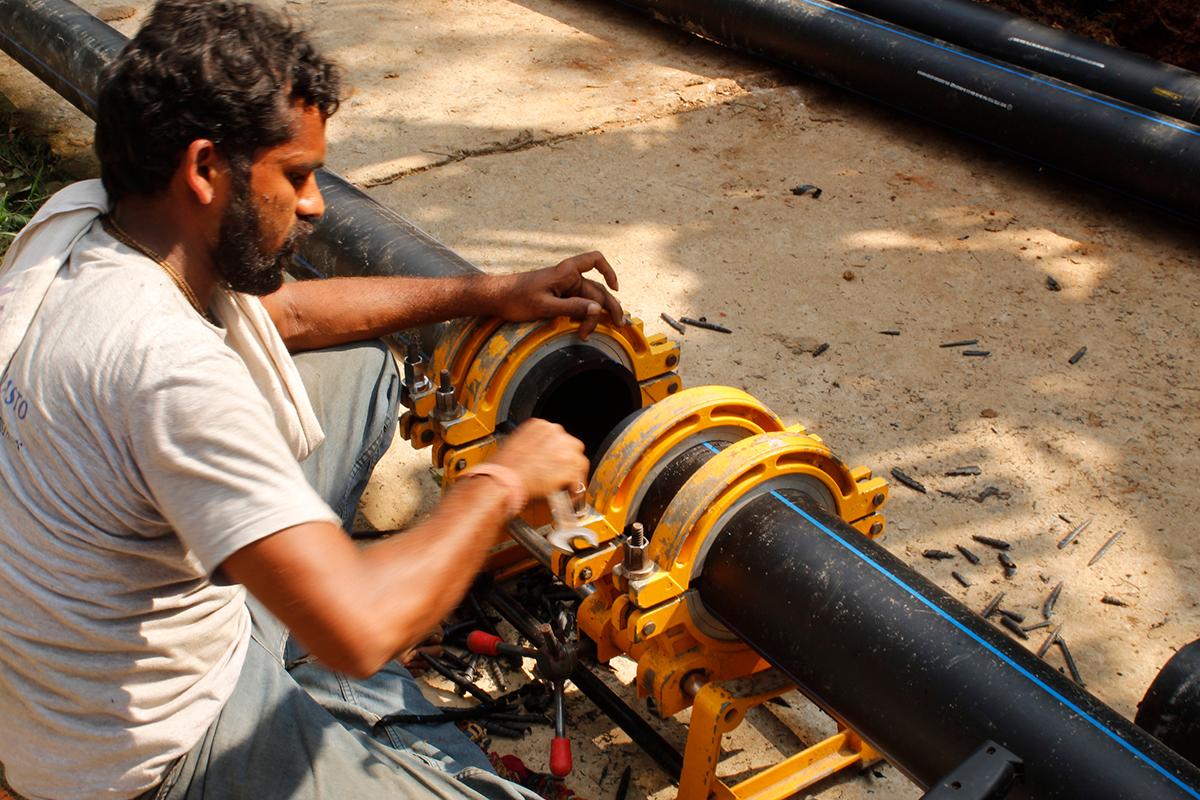Why Is PVC Bad for the Environment?
Updated Dec. 18 2020, 4:21 p.m. ET

Plastic is bad for the environment. Duh — we already know this. We also know that it’s bad for our health, too, as it’s a synthetic material, it can leach out toxins, additives, and other harmful chemicals that can cause health problems. Exposure to some plastics can even cause cancer in the long run. Though we may be able to recognize plastic-related buzzwords in our society — like, how nearly everyone thinks BPA is the plastic additive from Hell — there are other types of plastic that tend to fly under the radar. But that doesn’t mean they are any healthier or any safer than the stuff that, publicly, gets a bad rep. PVC — or polyvinyl chloride or vinyl — is one such harmful material.
Polyvinyl chloride — or PVC as it’s commonly known — is indeed a type of plastic. Though it often hides under the guise of vinyl, it’s a type of synthetic plastic that can either be made rigid or flexible. As per to PlasticsEurope, PVC was one of the first plastics ever discovered. Now, it's one of the top three most-used synthetic plastic polymers out there.
But despite how widely it is used throughout the world, PVC is very dangerous. In fact, Healthy Child Healthy World claims that PVC is one of the most toxic plastics out there. And yet, PVC is found in almost so many of the things we use every day, including pipes, window frames, toys, bottles, blister packs, shoes, credit cards, drawer slides, and more.
Why is PVC harmful?
According to Greenpeace, PVC poses serious threats to both human health and the environment during every point of its lifecycle, and the organization even believes that "PVC is the single most environmentally damaging of all plastics.”
The reasons why PVC is so harmful can be summed up by two words: chlorine and dioxin. Greenpeace states, “PVC production is the largest and fastest growing use of chlorine — accounting for nearly 40 percent of all chlorine used in the United States. Chlorine is the basic building block of our most infamous toxic problems: CFCs, which destroyed the ozone layer, the dioxin contamination at Love Canal and Times Beach, Agent Orange, PCBs and DDT pesticides.”

Greenpeace continues, “Hundreds of chlorine-based toxins are building up in the air, and DDT pesticides. Hundreds of chlorine-based toxins are building up in the air, water, and food chain.”
In addition to using so much chlorine, the creation of PVC also creates dioxin and dioxin-like compounds. World Health Organization describes dioxins as “a group of chemically related compounds that are persistent environmental pollutants (POPs).”
These compounds are created whenever chemicals are created from chlorine. WHO adds, “Evidence suggests that, throughout its entire lifecycle, PVC is responsible for a greater share of the nation’s annual dioxin burden than any other industrial product…. Dioxin is known as one of the most toxic chemicals ever produced.”
In fact, the Environmental Protection Agency (EPA) does not believe that there is any safe level of dioxin exposure.
Why is PVC bad for the environment?
The process of making PVC is harmful for the environment, and since most of the PVC plants are located in either Texas or Louisiana, these states are more likely to be harmed by PVC pollution.
Greenpeace explains, “These plants release huge amounts of toxic chemicals into the environment around them. Discharged pollutants impact nearby drinking water supplies and on-site incinerators spread dioxin and other hazardous compounds in the air.”
As a result, Greenpeace surmises that communities, farms, and fishing areas nearby are negatively impacted by the spread of PVC chemicals. The dioxins PVC causes accumulate in animals’ fat once exposed, then the dioxides make their way up the food chain. But the harm of these chemicals inside the animals’ bodies does not stop there. Dioxins as a result of PVC may disrupt the hormones of animals, causing birth defects, infertility, and developmental problems with their young.
Is PVC eco-friendly?
PVC is not considered eco-friendly. It is made by a chemical reaction between chlorine, carbon, and ethylene and because it causes the release of other harmful chemicals, it does a lot of harm to the environment. In order to be transformed into a material that can be used in textiles or packaging, phthalates — which are plasticizers — are added, therefore adding another layer of harmful chemicals.
How does PVC impact environmental racism?

Another criticism people have about PVC is the role production of PVC plays in environmental racism.
According to Green Action, environmental racism is defined as “institutional rules, regulations, policies, or government and/or corporate decisions that deliberately target certain communities for locally undesirable land uses and lax enforcement of zoning and environmental laws, resulting in communities being disproportionately exposed to toxic and hazardous waste based upon race.”
Environmental racism disproportionately affects people of lower socioeconomic status. Since most of the PVC plants that produce PVC are located in poor communities in either Louisiana or Texas, this is a classic example of environmental racism. These communities are affected more so by the chemicals of the PVC plants, causing more health and fertility problems in communities that, financially, cannot afford such health issues.
In 1987, Reveilletown, La. — which was initially founded by freed people who were formerly enslaved — was forced to close; after becoming contaminated beyond repair by the Georgia Gulf Corporation’s production of plastics and vinyl window frames, the town’s residents were forced to relocate. The homes, and all other structures, were torn down, leaving nothing left of historic Reveilletown.
What are the alternatives to PVC?
PVC is everywhere, making it difficult to avoid the material entirely. But fortunately, there are plenty of natural alternatives to PVC that are used in products, such as natural rubber and latex.